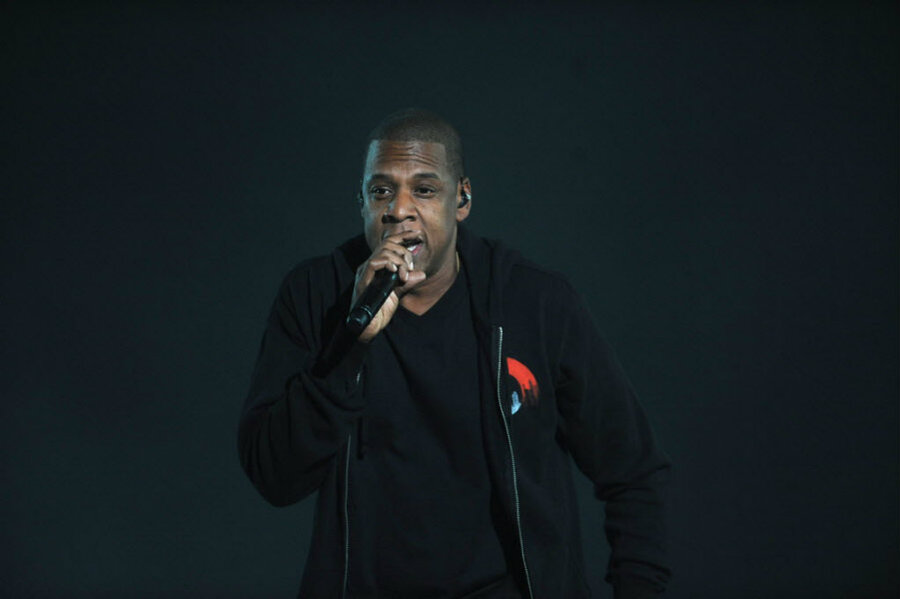Can Tidal 'reestablish value of music' or just pad coffers of mega-stars?
Loading...
| Los Angeles
Jay-Z wants to reclaim the music industry for musicians.
The hip-hop mogul released his plan to revamp the way that consumers stream music via a star-studded press conference Monday promoting the premium music streaming service Tidal.
Jay-Z did not speak, but rhythm and blues singer Alicia Keys read a statement expressing the rapper’s and his fellow co-owners’ intent “to forever change the course of music history” with “the first ever artist owned global music and entertainment platform.”
“Today marks the true beginning of a mission to change the status quo, to reestablish the value of music,” Ms. Keys said.
Jay-Z recently purchased the service for $56 million and brought in a who’s who of music royalty as co-owners, including Keys, Rihanna, Kanye West, Madonna, Nicki Minaj, Jack White, and members of the band Arcade Fire.
The co-owners say the artist-owned service will help to address concerns in the music industry that musicians are inadequately compensated for their music by other streaming services such as Spotify and Pandora, which offer free, ad-supported music to consumers.
For musicians, Tidal’s promise of equitable returns for artists is a welcome change for an industry that has seen diminished revenue since online music sales and streaming (to say nothing of illegal "sharing") displaced record stores as the main pipeline channeling new music to fans. However, critics wonder if consumers will be willing to shell out $10 to $20 a month for a premium music service – and, if they do, who will profit, struggling artists or the multimillionaire co-owners?
“Right off the top I think it’s fantastic that they are going to do this. Anyone trying to solve the problem of getting money to creators I am all for. Thank you, yes, please do this,” says Richard Gibbs, a Malibu-based composer who has composed film and television scores including “Dr. Dolittle,” “The Simpsons,” and Battlestar Gallactica.”
Mr. Gibbs has long and actively lobbied for a new economic model for the music industry that would help support new artists, but is skeptical that fans accustomed to free content will be ready to foot the bill for that model.
“I see the challenge of this as not being competitors such as Spotify and iTunes, but an entire generation that is used to getting all their music for free,” says Gibbs.
Some 15 million Spotify subscribers do pay for ad-free content, representing one quarter of the service’s 60 million subscribers. Musicians have accused Spotify and other streaming services of cheapening the value of music by making content available for free. Grammy-winning star Taylor Swift pulled her entire catalogue from Spotify in November because “music should not be free.”
Tidal will not offer any free or ad-supported subscription, and instead will offer subscribers two tiers to choose from: a basic package with status-quo quality streaming for $9.99 per month and a premium option, which includes high-definition, CD-quality streaming and additional editorial content for $19.99 a month.
The basic package is relatively comparable in price to competitive brands and presumably will yield similar returns for artists. Premium subscriptions will theoretically fund higher returns for artists. The company has not yet specified what rates artists will receive in exchange for use of their music and how that might vary depending on the consumers’ subscription choice.
The premium tier’s promise of higher quality sound will undoubtedly attract some die-hard music fans and audiophiles, says Michal Ann Strahilevitz, a professor of marketing at Golden Gate University. Whether that will represent enough of a market share remains an open question.
“They won’t flop, but they won’t get more than a small fraction of the total of the growing streaming music business,” Professor Strahilevitz says.
However, the majority of young people – by far the largest music-buying demographic – are not audiophiles and may not even have the necessary equipment to fully appreciate the premium tier’s higher quality sound, points out Shawn Prez, CEO of Power Moves Inc., a guerrilla marketing company in New York.
“More times than not people are listening to their music through their headphones or basic speakers, where they won’t be able to tell the difference between standard and high definition sound,” Mr. Prez says. “There is not a big enough differentiator to encourage consumers to leave their current streaming service or begin to stream with Tidal.”
Daniel Sean, a 24-year-old graduate from California Institute of the Arts counts himself in that camp. He says he “perfectly happy” with his $8 per month Spotify subscription and sees “no reason to switch."
Mr. Sean says he is dubious about the emphasis placed on the big names behind Tidal. That skepticism, analysts including Strahilevitz say, may be a barrier to success.
“So far, the musicians behind the project are not starving, talented, new artists, but very established and extremely wealthy musical celebrities. It is one thing to pay a bit more for fair trade goods so that subsistence farmers will be paid a living wage for the products they produce,” she says. “However, the people behind Tidal already have thousands of times more wealth than most of their fans. Even the most devoted fan is unlikely to feel compelled to pay a premium so that their favorite multimillionaire artists will have yet another private jet.”
However, for singer/songwriter David Berkeley, the stakes for independent artists are too high to entirely dismiss the possibility that Tidal could bring positive change to the industry.
“Needless to say, it’s hard to make it as an independent musician,” he says in an e-mail to the Monitor. “Sites that help expose people to new music without preventing them from wanting/needing to buy product from me are great. But if the trend continues and fewer and fewer [people] need to buy, it will become more challenging for artists like me to survive out there. If Tidal can alter that trend, then great.”







